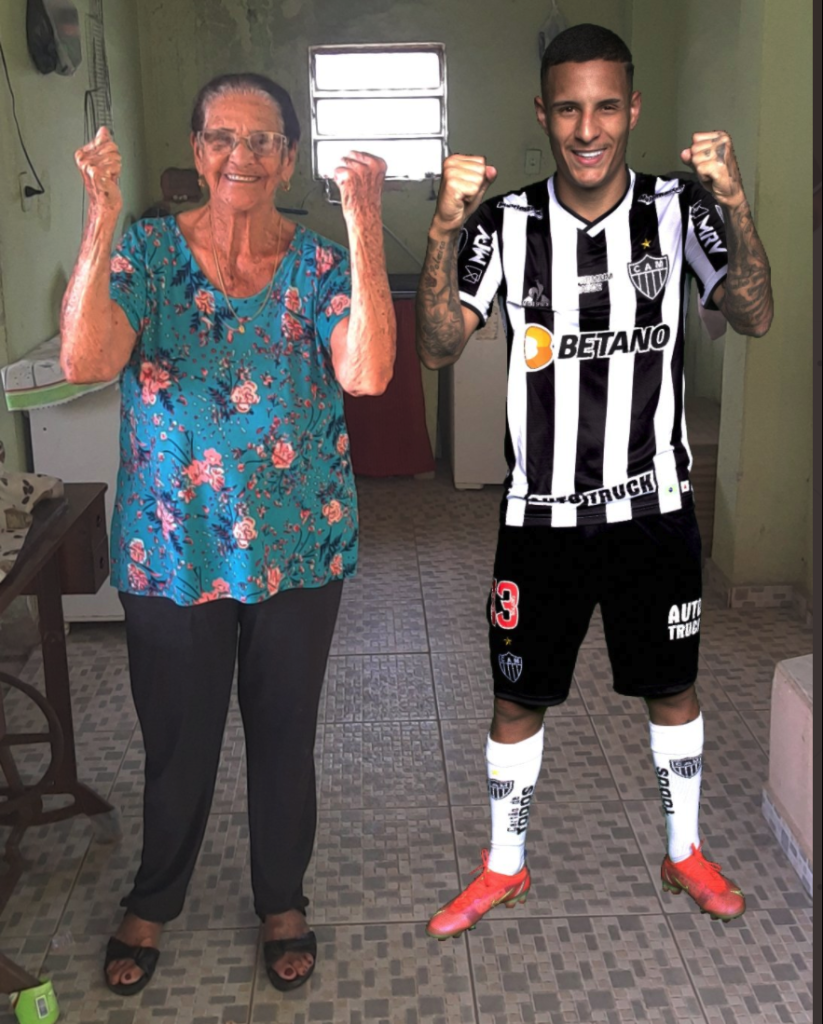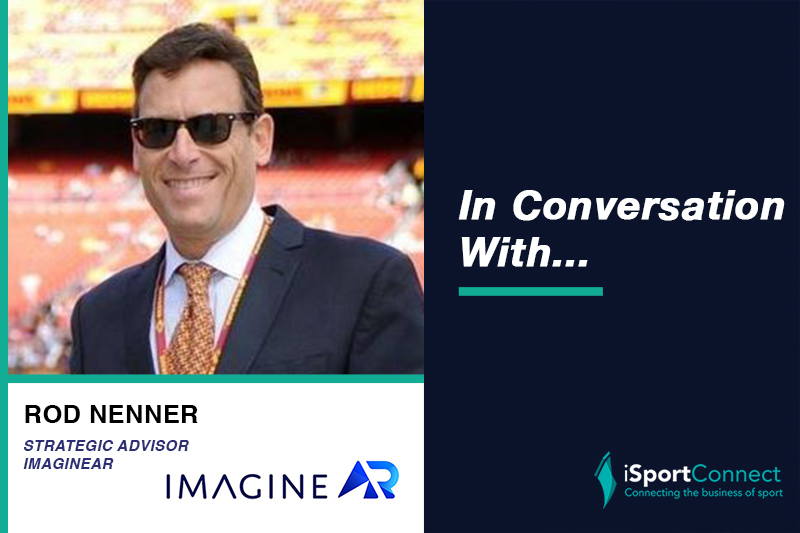“Understanding The Mentality Of The Fan Is Important, You Don’t Want To Turn Them Off”
October 20, 2021
iSportConnect talks to Rod Nenner following his move from the Washington Football Team to ImagineAR. Rod gives his thoughts on some of the key monetisation challenges for sports teams currently.
ImagineAR, an augmented reality company that enables sports teams, brands and businesses to instantly create their own mobile phone immersive AR campaigns, has announced that Rod Nenner has joined the Company as a strategic advisor to market the ImagineAR Fan Engagement Platform to the Sports Industry & Consumer Brands in North America.
Rod Nenner has spent 18 years with the NFL’s Washington Football Team (formerly the Washington Redskins) as Vice President of Corporate Partnerships where he opened and managed many of the team’s largest partners including naming rights to the team’s practice facility, several clubs areas & gate entitlement at FedExField and monetizing the team’s intellectual property including team branded lottery tickets and restaurants. During his tenure the Washington Football Team was one of the most profitable teams in all of sports and in the top 5 most valuable franchises in the NFL in part due to his local, regional and national partnerships.
According to Rod, “Today teams, leagues and venues are looking for new and exciting ways to engage fans, augmented reality does just that…it’s new exciting and fans love it”, he added “when done right it provides the fan a real connection to their team and the players they love.”
Alen Paul Silverrstieen, CEO and President of Imagine AR, said: “We have added a number of high-profile successful and experienced thought leaders in the global world of sports this summer including Ryan McCumber, Jerome DeChance, and today Rod Nenner. This talented group has demonstrated an impressive track record of success for decades bringing sports technology solutions to major sport leagues, teams, clubs, and brands. Combined with the launch of our new AR Cloud 2.0 Platform, SDK (Software Developer Kit) Version 1.4, and GDPR Platform Compliance this fall, ImagineAR is well positioned to grow revenue and deliver significant partnerships for the remainder of 2021 and the new year.”
Ben Page spoke to Rod to get his thoughts after his move across.
Rod Nenner on… the biggest challenges faced by sports teams currently in how they make money and create revenue over the past 18 months.
Creating revenue is obviously important. During the pandemic many of the traditional revenue streams simply were not available; ticket, merchandise and concession sales and sponsor activations were gone, but the smarter teams realised that the gameday experience, while important for revenue, was important for fan engagement.
The first question they tackled was now that we don’t have a gameday how do we create better connections with our fans? Sure we have TV, radio, digital and social media…but ‘how do we do that better?’ Without people in the stadium, how do we recreate the game-day experience at home?
“We didn’t want to disenfranchise our broadcast partners, so we had to create an experience that didn’t necessarily disrupt the relationship fans have with the television broadcast.”
There are teams who successfully created what I would call a “second screen experience” which allowed the fans to almost feel participatory in the gameday event. I’m not suggesting it was as exciting as being at the game, but you have the giant digital screens in stadiums, why not have that on your phone or tablet?
There were big questions as to how we could get all of our partners involved, our naming rights partners for example. So a lot of it was about porting those sponsors into that second screen or virtual experience which added “value” to the TV experience.
Rod Nenner on… creating the balance with a second screen aspect in order to not overly distract from the paying broadcasters?
We didn’t want to disenfranchise our broadcast partners, so we had to create an experience that didn’t necessarily disrupt the relationship fans have with the television broadcast.
We needed to find out how to change our digital experience to make it more engaging for the fans. What kind of information are they lacking which we can provide them? We had to find the right information and deliver it at the right time, in the right way…not too much, not too little.

Most important is how we integrated sponsors in a contextual and relevant manner, that’s important too. You just don’t throw a logo on something that’s not relevant; fans will pick up on that.
Rod Nenner on… whether sports teams are under pressure to create too much content as fans want to consume so much, and whether it’s difficult to get a clear focus?
It’s a fine balance and I think the good content teams understand what to produce, what to publish and when to publish it. There’s always a constant discussion between the sales teams, the revenue generators and the content people, where the revenue generators say ‘let’s put a logo on that, this company makes security products’. But you have to ask yourself does that actually make sense? Understanding the mentality of the fan is important, you don’t want to turn them off.
“If you look at a team, whether you have 20 million fans, or just 100,000 fans for that matter, the idea is you want to create something that all fans can acquire, not something ten fans can acquire.”
Fans aren’t stupid, they understand advertising is necessary and part of the experiences, but don’t constantly hit them on the head with the advertising. Good content, delivered in a relevant contextual format at the right time is appreciated, and if the sponsor is tastefully integrated fans will appreciate it and the positive feeling carries over to the sponsor…when done right fans may even start looking for the “Lays Crisps Crunch of the Game”.
Rod Nenner on… the growth of NFTs and their importance for sports franchises?
NFT’s are owned by the rights holder and it’s up to the rights holder how they want to monetise their rights. The big question is it purely monetisation or is it about fan engagement? I think the NFTs of tomorrow will be a little more special than the NFT’s of today. It’ll be tied to some kind of contract such as blockchain tickets or other memorabilia which has a purpose, as opposed to just a screenshot or gif.
We’re in a watershed moment, looking at what is the blockchain and what is a smart contract. I’m quite positive that where we are today is not where we’ll end up in five years or even one year from today.
If you look at a team, whether you have 20 million fans, or just 100,000 fans for that matter, the idea is you want to create something that all fans can acquire, not something ten fans can acquire. It’s not about ten NFT’s selling for $10,000, it is about 1,000,000 NFTs selling for $1.
Rod Nenner on… joining ImagineAR in an advisory role and what the company can offer to franchises.
What we’re seeing with AR today is different to what we’ll see tomorrow, it’s a growing or evolving technology that’s been around for years. Four or five years ago it was hard to use and it was clunky, it’s becoming easier to use and ImagineAR is part of that evolution.
“The business side, the advertisers, the agencies are also asking how do we leverage technology to create that connection with the fan?”
Now a team doesn’t need to hire a studio and spend thousands of dollars to create an AR campaign. Today if a team is going to use it, it’s going to because it adds a fan engaging factor to it. It’s interesting, it’s fun, it makes my team cool to be associated with. Fans can say ‘I love my team, my team loves me because look they gave me this cool AR piece I can share with my friends and family.’
Rod Nenner on… learnings from 18 years in the commercial side of sport.
Teams need to evolve, to not only be where the fan is but leverage technology to give the fans what they want, where they want it. That’s accessible anytime, anywhere, in a format that makes sense. And the business side, the advertisers, the agencies are also asking how do we leverage technology to create that connection with the fan?
Some teams are fast leaders, you can tell who they are, exploring and testing anything, while others are fast followers, they won’t pick up a product or service for a year or two until other teams have proved it works. But a lot of times I saw it was the advertisers or sponsors who said ‘hey what about this?’. The teams who are more commercially successful evolve faster than the less successful teams.
So be willing to test. And listen to not only what your advertising is saying, but also what the younger people in the organisation are saying and pay attention to the trends across the sports business industry.
You have to evolve. In today’s world if you are not are not moving forward, you are moving backwards.



